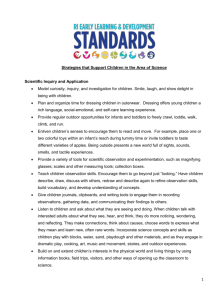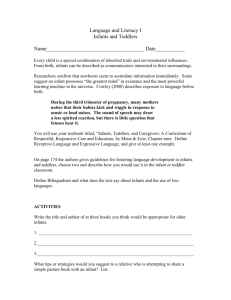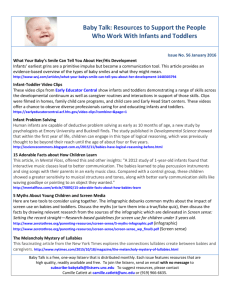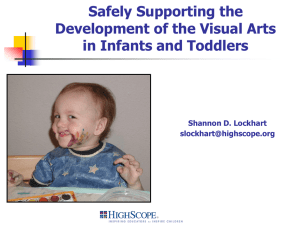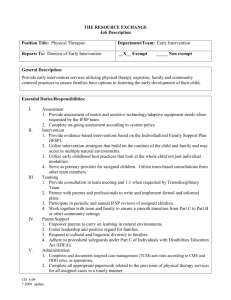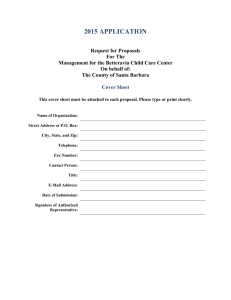Perceptions of Death and Dying in Children
advertisement
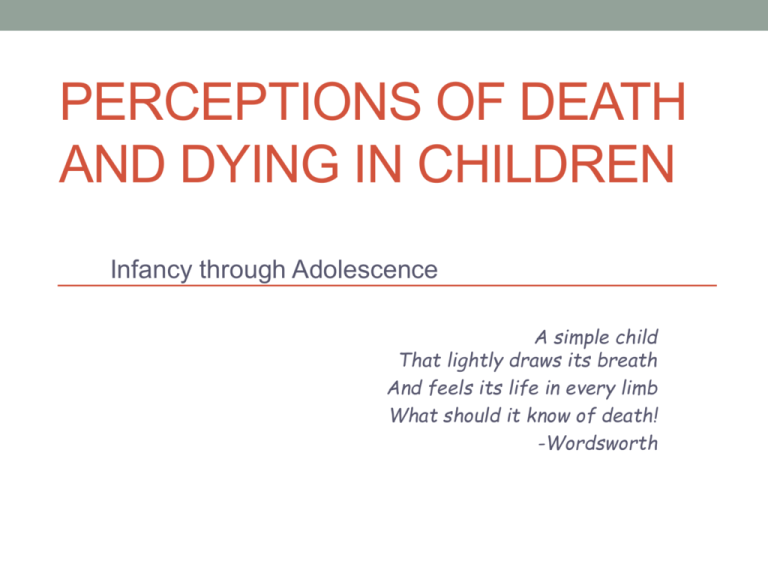
PERCEPTIONS OF DEATH AND DYING IN CHILDREN Infancy through Adolescence A simple child That lightly draws its breath And feels its life in every limb What should it know of death! -Wordsworth Nurse’s Role • The nurse is often asked to respond to children’s questions about death and to advise parents and teachers on how to discuss this topic with children. • It is essential for the nurse to know the cognitive limitations of children at various stages of growth and development that may result in misinterpretation or guilt related to the death of a loved one. • Following is a brief summary of 4 basic concepts of death and the behaviors and common developmental characteristics of infants & toddlers, preschoolers, school age, & adolescents. 4 Concepts about Death 1. Irreversibility—refers to the permanency of death. Children may perceive the deceased as having gone away on a trip, and may get angry when that person doesn’t return. Concepts of Death cont’d 2. Finality (Nonfunctionality)— The state in which all life functions cease completely. • Young children often attribute life to all objects. This is referred to as “animism”. • They may fear that the person who died will not be able to “see” in the coffin once it is closed, because they cannot comprehend the “ending of all life functions” that occurs with death. Concepts about Death (cont’d) 3. Causality—children must be helped to understand the true causes of death. • Magical Thinking may cause the child to assume responsibility for the death of a loved one by concluding that their bad thoughts or unrelated actions were the cause of the person’s death, leading to excessive guilt. Concepts about Death cont’d 4. Inevitability (universality)— Everything that is alive must eventually die. • Children may initially think of themselves and their family members as immortal. Then, when someone dies, they fear that everyone close to them will die. • Helping children to understand that each person has his/her own time to die is important. Questions the nurse might ask to assess the child’s understanding of death— • When someone dies, can they come back to life again? (irreversibility) • What happens to people after they have died? Can they still see or hear or feel pain? (finality) • What causes people to die? (causality) • Who dies? Does everyone eventually die? (inevitability) Cognitive Perceptions based on Developmental Stage • Infants and Toddlers • Even infants can respond to maternal depression when grieving. They cannot cognitively understand death, but they sense a change in routine and emotional responses of parents. Feeding and care-giving patterns should be maintained. • Infants and Toddlers (cont’d) • With the development of “object permanence” that begins in the 2nd half of the 1st year of life, infants & toddlers become capable of understanding loss & the concept of “gone”. • The game “peek-a-boo” has been suggested to be one of many games about death. It involves repetitive separation and reunion with important caregivers and may represent an attempt to understand and deal with loss. • Preschoolers • Tend to deny death as a normal & final process. Death is like sleep: you are dead, then you are alive again. Or it is like taking a journey: you are gone, then you come back again. The belief in the reversibility of death is a source of comfort. Preschoolers (cont’d) • Because of egocentricity—seeing things only from their perspective, and • Magical thinking—creating imaginary cause/effect relationships that may be unrealistic, they cannot comprehend the universality and permanence of death, and may react with intense anger or sense of guilt because of a misinterpretation of the cause of death and the inability to “wish” the person back to life. • School Age • 6-9 years: early school-age closely resembles the preschooler. They do begin to see death as final & that people they love can die. They may be interested in the biological aspects of death. • Website with counsel for teachers and caregivers • National Center for Grieving Children & Families School Age (Cont’d) • 9-12 years: As Concrete Formations develop further, death becomes personal, irreversible, & inevitable. • Some children may experience separation anxiety, be fearful & reluctant to leave home & parents. • To protect themselves or hide from fear, school-age children may create stories or jokes about death. • Explanations need to be simple, concrete, & honest. • Adolescence • Teenagers have completed cognitive development of concepts of time, space, quantity and causality which gives them a framework within which the idea of death can be placed. • They fluctuate between “knowing” that death is final and inevitable, and believing that personal mortality is an unfounded rumor. • Their defiance of death may explain some of their risktaking behavior— “it can’t happen to me”. Adolescense (Cont’d) • Have the most difficulty in coping with death. May feel alone. • Concern is for the present much more than for the past or the future • It is important to engage the teenage child in conversation that fosters an openness to express feelings of grief and loss. Nursing Interventions when Dealing with Children’s Reactions to Death • Infants and Toddlers • Help parents deal with their • • • • feelings so that they can meet the emotional needs of their little ones Encourage parents to stay as close to their children as possible, yet recognizing the parents’ needs Maintain normal schedules, routines, rituals as much as possible If a parent has died, strive to provide a consistent caregiver for the child Promote primary nursing • Toddler • Help parents deal with their feelings so that they can • • • • meet the emotional needs of their little ones Help parents to understand behavioral reactions of their children e.g. regression in development, temper tantrums, etc. Encourage parents to stay with the child as much as possible as there may be great fear of separation from parents If a parent has died, strive to provide a consistent caregiver for the child Promote primary nursing • School age • Help parents deal with their feelings so that they can meet the emotional needs of their little ones • Encourage parents to stay as close to their children as possible, yet recognizing the parents’ needs • Because of the children’s fears of the unknown, anticipatory guidance is very important • Because the developmental task of this age is industry, interventions of helping children maintain control over their bodies & their understanding allow them to achieve independence, self-worth, & self-esteem & avoid a sense of inferiority • School Age (continued) • Encourage children to talk about their feelings & provide aggressive outlets • Encourage parents to honestly answer questions about dying rather than avoiding or fabricating euphemisms • Encourage parents to share moments of sorrow with their children • Provide preparation for post-death services in response to questions about what happens to the body • Adolescence • Help parents deal with their feelings, allowing them more emotional reserve to meet the needs of their children • Avoid alliances with either parent or child • Answer adolescents’ questions honestly, treating them as mature individuals & respecting their needs for privacy, solitude, & personal expressions of emotions • Help parents understand their child’s reactions to death/dying, especially that concern for present crises, may be much greater than for future ones, including possible death Bereavement Programs • Grieving after the death of a child is a long-term process that cannot be resolved in the traditional health care system. • Follow-up phone calls to the family one month after the loss of a child will help to assess how the family is progressing through the grieving process. • Referral to a support group such as The Compassionate Friends, (www.compassionatefriends.org) a national organization for bereaved families, parents, and siblings may be helpful. • The goal of such a bereavement program is to help the family in the process of coping with the devastating impact of the loss of a child and, hopefully, with grief resolution. There you have it! Resource Now please go to Reggienet and complete the online quiz based on this content on “Children’s Perceptions of Death and Dying.”

